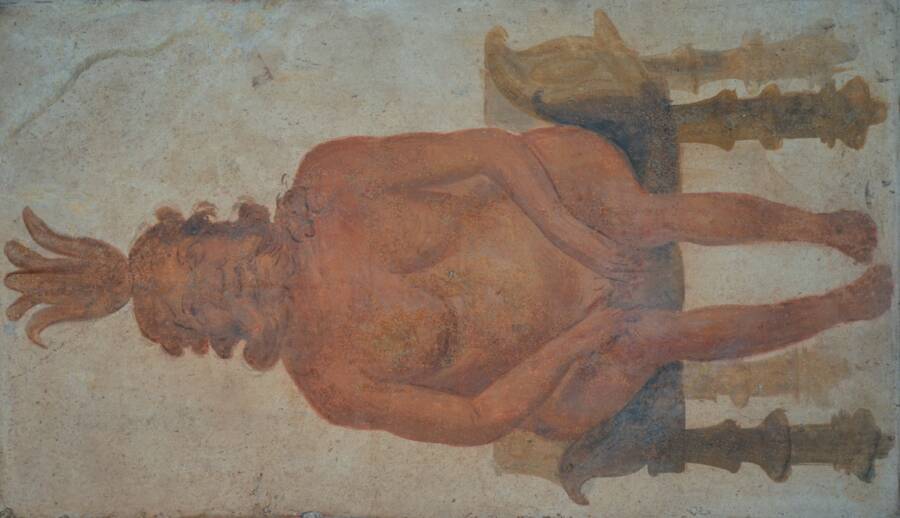The ancient cocktail was consumed by a cult dedicated to the deity Bes, who served as a protective spirit, particularly to mothers and children.

Tanasi et. al/Tampa Museum of Art in FloridaThe Bes head vase analyzed in the study.
An ancient Egyptian cult dedicated to a deity known as Bes consumed an odd mixed drink for their ritual practices: a mixture of booze, honey, human blood, and hallucinogenic plants.
The strange cult practice was revealed thanks to an in-depth chemical analysis of an ancient Bes vase released on the pre-publication feedback site Research Square.
“We successfully identified the presence of various nutraceutical, psychotropic, medicinal, and biological substances, shedding light on the diverse components of a liquid concoction used for ritual practices in Ptolemaic Egypt,” researchers wrote.
Through their analyses, they made several interesting observations. First, they discovered the presence of trace amounts of Peganum harmala and Nymphaea caerulea — more commonly known as Syrian rue and blue water lily, both of which have psychotropic and medicinal effects.
Researchers noted that Syrian rue seeds “produce high quantities of the alkaloids harmine and harmaline, which induce dream-like visions.”
Even today, Syrian rue is sometimes combined with other plants like mimosa to create a similar psychedelic effects to those produced by ayahuasca.
“Additionally,” the researchers wrote, “the identification of human fluids suggests their direct involvement in these rituals.”
But the strange brew featured far more than just human liquids and psychedelic plants. Researchers also found evidence of “fermented fruit-based liquid and other ingredients such as honey or royal jelly.”
As for which “human liquids” researchers found in the vase, they identified blood, breast milk, and a third substance that may have been vaginal mucus discharge. It’s likely that the booze and sweetening agents were used to mask the taste of some of the more unsavory elements of the mixture.

According to Ancient Origins, Bes, a part-feline, part-human deity, was worshiped as a protective spirit said to have the power to guard its worshipers from evil intent. Bes was considered to be particularly protective of mothers and children.
The ancient elixir drunk by Bes worshipers was typically done so out of ceramic drinking mugs decorated with the head of Bes, which allowed researchers to pinpoint the origins of the vase they examined.
“As the Bes figure was revered as a protective genius, it might be assumed that the liquid drunk from these mugs was considered beneficent,” the researchers wrote.

Wikimedia CommonsA fresco from the Temple of Isis depicting the god Bes, who was worshiped by a cult that drank the strange cocktail.
The vase used in the study, dated to the second century B.C.E., was being held in the Egyptian collection at the Tampa Museum of Art in Florida, where American and Italian researchers conducted a thorough analysis using liquid chromatography with tandem mass spectrometry (LC-MS/MS). This chemistry technique combines the physical separation capabilities of liquid chromatography with the mass analysis capabilities of mass spectrometry.
Liquid chromatography separates mixtures with multiple components, allowing them to be analyzed individually, while mass spectrometry provides spectral information that can be used to help identify (or confirm the identity of) each of those separated components by determining their molecular weight.
This process allows researches to know not just what went into the drink, but also what each component added to it was made of.
Beyond the chemistry of it all, though, this study highlights a unique component of life in ancient Egypt. While the pantheon of ancient Egyptian gods has been relatively well documented throughout history, much of the specifics of ancient Egyptian religious practices remains a mystery.
As the researchers wrote in the study, “This multidisciplinary study highlights the complexity of ancient cultures and their interactions with psychoactive, medicinal, and nutraceutical substances.”
Spiritual relationships with psychotropic substances have been documented in cultures across the world as well, such as the Navajo and their rich history with peyote.
“These findings contribute to our understanding of ancient belief systems, cultural practices, and the utilization of natural resources, ultimately enhancing our knowledge of past societies and their connection to the natural world,” the researchers wrote.
After learning about this ancient Egyptian cult cocktail, check out this 1,700-year-old sock that reveals the height of ancient Egyptian fashion. Or, learn why the ancient Egyptians violently sacrificed kittens and cobras before mummifying them.





